“Congratulations mate, you’ve just won your first bream comp.”
The voice at the other end of the phone line belonged to Shane Wolhuter, a top line Brisbane fisho who is starting to put together some good results on the bream tournament scene. Of course I hadn’t actually won anything, I hadn’t even left the shed. What Shane meant was that he’d just won a comp. using the Jelly Prawn Lures that we’d made for him.
This was all very exciting and made me feel all warm and fuzzy, but the really interesting part was how he’d won it – by inshore switch baiting.
Switch baiting is the time honoured technique used by game fishers to stir up marlin, sailfish and other big offshore species. The method is fairly simple, they set up a trolling run with a good spread of teasers to raise their quarry from the depths. Once a fish is raised and gets fired up by the commotion of the teasers, they switch a live bait, lure or fly in front of it and bob’s their uncle.
Shane and his brother Nathan had used this same basic switch baiting method to turn sulky and shy bream into a tournament win at the Gold Coast Sportfishing Club’s annual Easter Classic. Now Shane is a very good angler, and so he should be, he seems to be on the water two or three days a week. But time on the water is not enough, it is attention to detail and the ability to react to change and modify your approach depending on conditions that leads to consistent success.
Bream are fickle creatures, sometimes they seem to develop an overinflated opinion of themselves and attempt to crash tackle anything that swims in their path (what can be referred to as a Trevor Gilmeister day) but at other times they will do nothing more than follow your lure at a distance of about 20cm, looking like they are about to do the business before losing interest and, frustratingly, ghosting away (more like the Ricky Stuart kind of approach).
I am no bream whisperer but I think it is just an energy conservation thing. Catching and pulling down a healthy and active bait fish probably requires a substantial investment of energy. At the end of the day why bother chasing, wrestling, trying to break to pieces, chew up and swallow a tough little bait fish when there is probably a school of small prawns floating around or a half-eaten hamburger lying on the bottom nearby? It is in this situation that switch baiting can turn frustration into consistent success.
The method is really quite simple. Basically, instead of using the teasers used by game fishers, you use hardbodied lures, and instead of switching a live bait into the mix, you use a small, lightly weighted soft plastic. This method is effective on pretty much all lure munching species, but we will stick with bream for now.
Make sure you use small hardbodies, the make and model isn’t that important, just stick to your favourite hardbodied bream lures. These lures are perfectly suited to catching bream so just use them as you normally would. And don’t worry, they will get their share of fish when using the switch baiting method. Next, add a small softy into the mix. This is where things get fun! Choose a small, lightly weighted prawn imitation – I might be a little biased but everything eats prawns. They are right at the bottom of the food chain and even the shyest, sulkiest fish find prawns hard to resist.
At the Easter Classic, Shane and Nathan fished Jelly Prawn Lures’ Mini Flicktails and Original Flicktails. The Wolhuter boys fish in tandem, which is probably the easiest way to use the switch bait method. One angler in the boat is on the ‘teaser’ (hardbody) and the other on the ‘switch’ (soft plastic). The bloke on the hardbody fishes hard into the structure first, then as the lure moves away from the structure the softy is placed in behind it. The theory is that the bream is following the hardbody out but isn’t quite ready to take the plunge and commit to the strike. When they see the little prawn flicking about haplessly away from any form of shelter, it is just too easy and down the hatch it goes.
Jelly Prawn Lures are perfectly suited to this style of fishing as they have a very slow sink rate and offer the perfect representation of a small and tasty prawn. The slow sink rate and ultra-realistic backwards kicking action lends itself perfectly to the flick-flick-pause type of retrieve that is so deadly on bream. The short, sharp flicks seem to get the attention of the fish and the long pauses give them the opportunity to grab an easy meal.
This method is best suited when fish are being targeted in well-defined structure. Pontoons, bushy bankside snags, fallen timber on the flats, and any other fish magnets are the places that can be targeted using the switch baiting method. Bream definitely do actively feed and hunt around this kind of structure but they will also use these areas, especially pontoons and deeper snags, for shelter and protection. When they are sheltering in this way, they may not be completely in the mood to actively hunt down their food and this is when switch baiting can turn frowns and swear words into the smiles and chuckles of a wily and contented angler.
It may seem to some that using a hardbody and a softy in tandem is simply a case of hedging your bets but the method of switch baiting really does seem to be greater than the sum of its parts. If you don’t believe me ask the 40 odd bream that Shane and Nathan nailed on a day that only a handful of other boats managed their five bream bag, how they felt about it?
I have focussed on bream here but the method is equally effective on pretty much all predatory fish. Those who sight-fish for flathead are becoming increasingly aware of their propensity to follow lures for quite some distance before either deciding to eat it or not.
Barra in the north are also absolute suckers for a bit of switch baiting, they seem to love a bit of activity in the water to get them in the mood for action but can be a little reluctant to over-commit to a big feed, especially in the cooler months.
Bottom line, give it a go. If you love to flick lures at structure but find those non-commitant follows a bit hard to swallow then this may just be the string in your bow required to give you that warm feeling of satisfaction that can only be felt when you manage to turn a tough day’s fishing into a day to remember.
Thanks to Shane Wolhuter of the Evolution Fishing Team and Shad’s Lures for teaching me this great fish-catching system.
Reads: 4348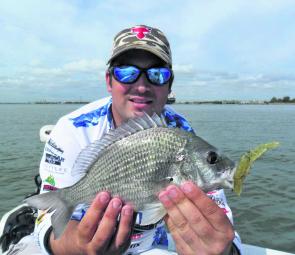
Shane Wolhuter of the Evolution Fishing Team and Shad's Lures put the switch baiting system to great effect in his win at the Gold Coast Sportfishing Club's Easter Classic
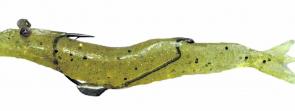
Jelly Prawn Flicktail is ideal for switch baiting a variety of species.
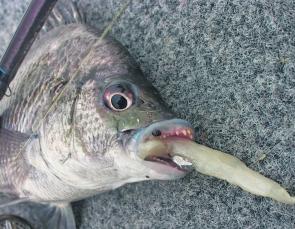
In the north, pikey bream are absolute suckers for a bit of switch baiting action. Image by www.fishingtownsville.net
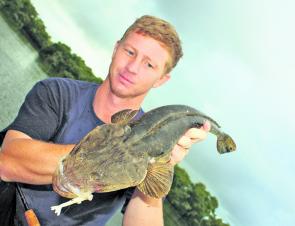
You can expect some great bycatch when using the switch baiting system. This solid flathead hit a small bait meant for bream right in amongst heavy cover.
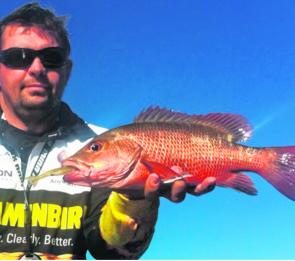
Jacks use pontoons and bankside snags as ambush points. Don't be surprised to get onto a few of these when switch baiting for bream.
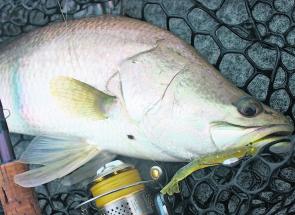
Anywhere from the Mary River north, you should expect plenty of barra when switch baiting the creeks. Image by www.fishingtownsville.net

This bream fell to a white Mini Flicktail Jelly Prawn Lure. With their slow sink rate, life-like appearance and ultra-realistic action, these lures lend themselves perfectly to switch-baiting.




